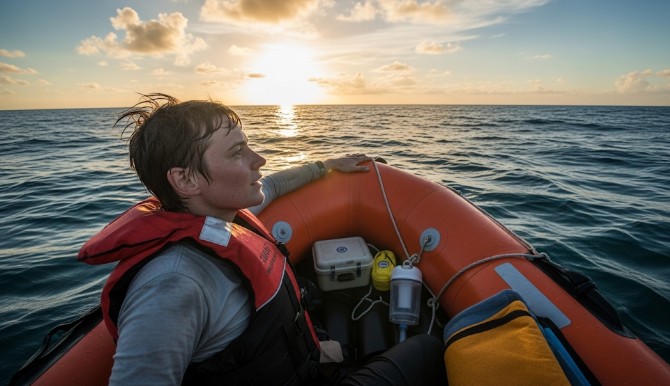Lost at Sea: First 24 Hours

Objective
Survive until pickup by prioritizing flotation, exposure control, and signaling while minimizing drift from your last known position. Don’t “swim for it.” Make yourself big, bright, and predictable to rescuers.
Scenario (Example)
Example: Two adults in a 16-ft center-console lose power 3 nm offshore on a rising afternoon sea. Batteries sag, cell service flickers. There’s a Type-IV throw cushion, two PFDs, a whistle, flares, and a small cooler. Weather shows a sea breeze increasing and a late squall line.
Step-by-Step
- Stabilize the platform (5 min). Distribute weight evenly to prevent capsize. If swamped but vessel floats, stay with the boat—it’s the biggest, most visible thing you have. Tie off anyone in the water to a bow or stern cleat with a short line.
- HEAT: Hypothermia/Exposure/Alert/Targets (10 min).
- Hypothermia: Get as much body out of water as possible—climb partly across gunwale, cooler, or cushion. Huddle if multiple people. Wear PFDs properly.
- Exposure: Rig shade with a towel/poncho and boat hook. Cover head/neck. Prevent sunburn and evaporative chill.
- Alert: Turn on any EPIRB/PLB immediately. If you have VHF, hail “Pan-Pan” on Ch 16 with position (lat/long, bearing to land, depth, landmarks). If GPS is dead, read compass and estimate distance from last waypoint.
- Targets: Don’t drift aimlessly. If safe, anchor to reduce leeway; otherwise deploy a makeshift drogue (bucket on a line) from the bow to keep the bow into waves and slow drift.
- Signal schedule (throughout). Conserve flares for line-of-sight assets (boats/helicopters) within a 1–2 minute approach window. Day: mirror, bright cloth, waving arms in slow deliberate motions. Night: strobe/flashlight in SOS (••• — — — •••). Use the whistle three short blasts every few minutes when you see traffic.
- Water & heat (hourly). Ration sips, not gulps. Shade matters more than you think—your sweat rate drops when you’re not baking. Do not drink seawater. If rain arrives, collect with clean plastic or a shirt stretched as a catch surface.
- Drift management (every 30–60 min). Note the sun’s position and wave sets to estimate drift direction. Tie a bright object (towel or spare line) as a “tail” so you can see your relative motion. If a squall is approaching and you can’t anchor, tighten the drogue line to keep the bow up-sea.
- Crew care (every 20–30 min). Check for seasickness, dehydration, or panic. Swap positions (shade vs. sun) and rehearse what each person does when a rescue boat is sighted—one signals, one keeps the boat stable.
- Night routine. Consolidate everyone into the most stable, highest part of the hull. Lash loose items. Keep the strobe/flashlight ready and cover it to preserve night vision. Agree on watch changes every 30–60 minutes.
Real Example
Three kayakers blown offshore in afternoon thermal winds linked up with a tow line, rafted beam-to-beam to create a wider radar/visual target, and used a mirror at sunset to hit a fishing boat on the horizon. They avoided the deadly “one tries to sprint in” mistake and were recovered within two hours.
Checklist
- People: PFDs on, head covered, hydration plan, buddy checks.
- Platform: stay with boat/debris, drogue/anchor set, bow to waves.
- Signals: EPIRB/PLB on, VHF Ch 16 calls, mirror/whistle/flares schedule.
- Nav: last known position noted, drift direction estimated.
- Admin: avoid fuel/chemical exposure; log times and actions with a marker on hull or cooler.
Contingencies
- Capzise imminent: Everyone on one side; on “count of three” roll with the wave, don’t fight it. Stay together and hold onto the hull.
- Storm line hits: Lash down; helmets/hats on; crouch low; keep bow to waves; ride it out. Lightning risk—avoid touching metal rails; keep limbs inside.
- No signaling gear: Tear reflective labels, use foil from snack packs or can lids as mirrors; tie light-colored clothing high; form the international distress signal (three of anything: objects, waves, blasts).
After-Action
Once ashore: hydrate, treat sun/wind burn, and document what failed (fuel line, battery maintenance, comms). Add a PLB, spare handheld VHF in a dry bag, proper drogue/sea anchor, and high-visibility panel to your kit. Schedule a practice “engine-out” drill next fair-weather weekend.
← Previous | All Articles | Next →
